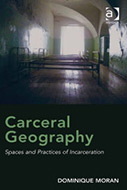Carceral Geography: Spaces and Practices of Incarceration

Author: Dominique Moran
Publisher: Farnham, Surrey; Burlington, VT: Ashgate, 2015. 185p.
Reviewer: Ian O’Donnell | November 2015
Carceral Geography is a manifesto for a new academic sub-discipline. But it is more than simply an exhortation to scholars to think differently about what they do. It is a call to action, a demand that those who care passionately about the reach of the penal state enter the arena of public debate to add their voices to the growing clamour for change. This is a book with an agenda, and the author is refreshingly transparent about her desire to combine academic engagement with informed advocacy.
Moran offers a tripartite analytical framework, “which may be broadly conceived of as the nature of carceral spaces and experiences within them, the spatial geographies of carceral systems, and the relationship between the carceral and an increasingly punitive state” (p. 2). She surveys the scholarship in each of these areas before offering directions for future research.
One of the ideas underpinning the book is that the punitive state has advanced to such a point that urgent action is required to restore a situation where a more parsimonious approach to punishment and social control becomes a political imperative. This narrative will be familiar to criminologists and of increasing interest to those in cognate disciplines, including geography.
The injection of a historical perspective exposes some of the fault lines in this argument. When one considers the wide array of institutions in which men, women and children have been deprived of their liberty over the past 100 years, it becomes evident that as the prison has become ascendant, other forms of what Eoin O’Sullivan and myself have termed “coercive confinement” have disappeared or diminished greatly in significance. (For a recent elaboration of this argument and its implications, see Coercive Confinement in Ireland: Patients, Prisoners and Penitents, 2012, Manchester University Press).
For example, in the mid-twentieth century more than one per cent of the population of Ireland was coercively confined in psychiatric hospitals, industrial and reformatory schools, mother and baby homes, Magdalen asylums, and prisons. This is higher than the rate of imprisonment in the US today which is, rightly, such a pressing concern to those who believe in justice and fairness. When a broader view is taken of punitiveness, something that the field of carceral geography seems singularly well-equipped to do, the pattern is of a major reduction in the detention of men, women and children.
A focus on coercive confinement rather than imprisonment opens exciting avenues for developing the ideas raised in Moran’s book. It chimes with her reliance on Erving Goffman, whose definition of a total institution as “a place of residence and work where a large number of like-situated individuals, cut off from the wider society for an appreciable length of time, together lead an enclosed, formally administered round of life” (p. 87), is cited with approval. It draws attention to the shifting nature of relationships between the state, society and the carceral. It introduces the family and the non-governmental sector (especially the Church) as important actors. It emphasises the spatial distribution of confinement and the close relationships between local communities and the institutions that serve their needs.
Historically, the rate of psychiatric hospitalization rose the further west one travelled in Ireland, a phenomenon that requires a social rather than a medical explanation. Moran’s discussion of the economic importance of prison building to impoverished rural communities in Russia and the US has clear parallels in other places at other times when decisions were being made about where best to locate new institutions, whether their orientation was towards punishment or welfare. There is nothing new about the state and its agents using institutions to manage difficult, deviant and disturbed populations; what has changed is the nature of the sites where this control is exercised, the entry and exit routes, and the extent to which the functions served have changed along with economic diversification, evolving social mores, and the niceties of realpolitik.
Moran stresses the importance of adding a temporal dimension to the mix so that our understanding of the lived experience of imprisonment takes account not only of relationships between people and across space but also of how time is worked with, felt, endured and overcome. Prisoners cannot avoid serving time in the sense of allowing it to pass in an environment that is not of their choosing and according to a timetable that is not of their design. However, they strive to avoid serving it as a slave would a master. In prison, clock time is displaced by social time. In this regard it is useful to think of the prison career in an explicitly chronological fashion, moving through an unsettling and tumultuous initial phase, followed by a period of tedium, before anxieties resurface as a release date approaches.
Prisoners find ways to cope with time’s passage and some surprise themselves with their resilience. Even when denied human company and held in the most austere forms of incarceration such as the solitary confinement cell of a maximum security prison, men and women manage to shape the environment that works upon them. They do so using stratagems that I have characterised, in ascending order of importance, as rescheduling, removal, reduction, reorientation, resistance, raptness and reinterpretation (see Prisoners, Solitude, and Time, 2014, Oxford University Press). It will be fruitful for carceral geographers to explore the contribution they can make to micro-sociologies of prison life, especially where the environment is stripped of external stimuli.
Moran notes the significance of mobility across sites of confinement and shows how this experience varies cross-nationally, referring to prison transfers in Russia, which can take up to three months of rail travel to complete. This is an aspect of the prisoner experience that has obvious adverse implications for family visitation. The dynamics of inter-institutional mobility constitute another worthwhile topic of investigation, incorporating the movement from juvenile to adult detention and from prisons to forensic psychiatric settings. Again the skills of the geographer have much to offer here.
Carceral Geography provides an interesting discussion of the need to scrutinise the process by which the construction of new prisons is influenced by competing philosophies of punishment, operational and administrative concerns, and architectural priorities. The role of the private sector in the tendering process is an additional consideration. This area merits close attention as decisions made at the design stage will have enduring implications. The originators of Pentonville Prison in London, inspired by the redemptive power of solitary confinement, could hardly have dreamed that the buildings would remain in use 170 years later, long after their animating philosophy had fallen into disfavour.
(Reading this book I was reminded of a conversation I had with a senior official involved in commissioning a gigantic new prison for Ireland’s capital city, who invited suggestions for the institution’s internal arrangements. I suggested that he design it as if his own child would be staying there. While it is unlikely that my advice had any practical effect – the plans to construct the prison were shelved when the national economy went into recession – it may have narrowed the empathy gap that exists between those who make decisions about the penal system and those upon whom their decisions take effect.)
Dominique Moran has stated the case for carceral geography and opened up several potentially productive seams of inquiry. The success of her endeavour will be measured not alone by how enthusiastically the project is grasped by the academic community, but by the degree to which it advances the “abolitionist praxis” (p. 151) to which its current proponents are committed.
Ian O’Donnell, Professor of Criminology, University College Dublin, Ireland.


